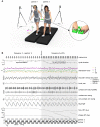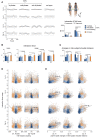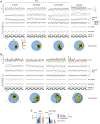Human-Human Interaction Forces and Interlimb Coordination During Side-by-Side Walking With Hand Contact
- PMID: 29563883
- PMCID: PMC5850283
- DOI: 10.3389/fphys.2018.00179
Human-Human Interaction Forces and Interlimb Coordination During Side-by-Side Walking With Hand Contact
Abstract
Handholding can naturally occur between two walkers. When people walk side-by-side, either with or without hand contact, they often synchronize their steps. However, despite the importance of haptic interaction in general and the natural use of hand contact between humans during walking, few studies have investigated forces arising from physical interactions. Eight pairs of adult subjects participated in this study. They walked on side-by-side treadmills at 4 km/h independently and with hand contact. Only hand contact-related sensory information was available for unintentional synchronization, while visual and auditory communication was obstructed. Subjects walked at their natural cadences or following a metronome. Limb kinematics, hand contact 3D interaction forces and EMG activity of 12 upper limb muscles were recorded. Overall, unintentional step frequency locking was observed during about 40% of time in 88% of pairs walking with hand contact. On average, the amplitude of contact arm oscillations decreased while the contralateral (free) arm oscillated in the same way as during normal walking. Interestingly, EMG activity of the shoulder muscles of the contact arm did not decrease, and their synergistic pattern remained similar. The amplitude of interaction forces and of trunk oscillations was similar for synchronized and non-synchronized steps, though the synchronized steps were characterized by significantly more regular orientations of interaction forces. Our results further support the notion that gait synchronization during natural walking is common, and that it may occur through interaction forces. Conservation of the proximal muscle activity of the contact (not oscillating) arm is consistent with neural coupling between cervical and lumbosacral pattern generation circuitries ("quadrupedal" arm-leg coordination) during human gait. Overall, the findings suggest that individuals might integrate force interaction cues to communicate and coordinate steps during walking.
Keywords: EMG activity; arm-leg coordination; human gait; interaction forces; interpersonal coordination; locomotor patterns.
Figures





Similar articles
-
Contributions to the understanding of gait control.Dan Med J. 2014 Apr;61(4):B4823. Dan Med J. 2014. PMID: 24814597 Review.
-
Interpersonal synchronization during side by side treadmill walking is influenced by leg length differential and altered sensory feedback.Hum Mov Sci. 2009 Dec;28(6):772-85. doi: 10.1016/j.humov.2009.04.007. Epub 2009 Sep 30. Hum Mov Sci. 2009. PMID: 19796834
-
Enhanced arm swing alters interlimb coordination during overground walking in individuals with traumatic brain injury.Hum Mov Sci. 2017 Apr;52:45-54. doi: 10.1016/j.humov.2017.01.001. Epub 2017 Jan 20. Hum Mov Sci. 2017. PMID: 28110146
-
Kinematic analysis of side-by-side stepping with intentional and unintentional synchronization.Gait Posture. 2010 Apr;31(4):527-9. doi: 10.1016/j.gaitpost.2010.01.013. Epub 2010 Feb 23. Gait Posture. 2010. PMID: 20181481
-
Spontaneous Interpersonal Synchronization of Gait: A Systematic Review.Arch Rehabil Res Clin Transl. 2020 Dec 24;3(1):100097. doi: 10.1016/j.arrct.2020.100097. eCollection 2021 Mar. Arch Rehabil Res Clin Transl. 2020. PMID: 33778472 Free PMC article. Review.
Cited by
-
Trends in Haptic Communication of Human-Human Dyads: Toward Natural Human-Robot Co-manipulation.Front Neurorobot. 2021 Feb 17;15:626074. doi: 10.3389/fnbot.2021.626074. eCollection 2021. Front Neurorobot. 2021. PMID: 33679365 Free PMC article.
-
Pose estimates from online videos show that side-by-side walkers synchronize movement under naturalistic conditions.PLoS One. 2019 Jun 6;14(6):e0217861. doi: 10.1371/journal.pone.0217861. eCollection 2019. PLoS One. 2019. PMID: 31170214 Free PMC article.
-
Spinal maps of motoneuron activity during human locomotion: neuromechanical considerations.Front Physiol. 2024 Jul 23;15:1389436. doi: 10.3389/fphys.2024.1389436. eCollection 2024. Front Physiol. 2024. PMID: 39108539 Free PMC article. Review.
-
Spontaneous gait phase synchronization of human to a wheeled mobile robot with replicating gait-induced upper body oscillating motion.Sci Rep. 2022 Sep 29;12(1):16275. doi: 10.1038/s41598-022-20481-4. Sci Rep. 2022. PMID: 36175591 Free PMC article.
-
In sync with oneself: spontaneous intrapersonal coordination and the effect of cognitive load.Front Hum Neurosci. 2025 Mar 24;19:1457007. doi: 10.3389/fnhum.2025.1457007. eCollection 2025. Front Hum Neurosci. 2025. PMID: 40196445 Free PMC article.
References
-
- Batschelet E. (1981). Circular Statistics in Biology. New York, NY: Academic Press.
-
- Berens P. (2009). CircStat: a MATLAB toolbox for circular statistics. J. Stat. Softw. 31, 1–21. 10.18637/jss.v031.i10 - DOI
LinkOut - more resources
Full Text Sources
Other Literature Sources

